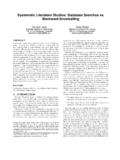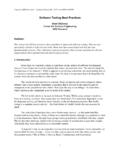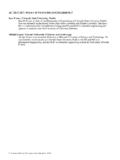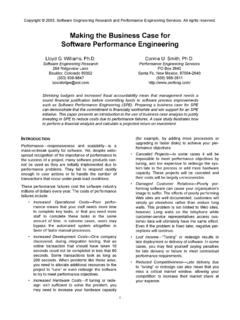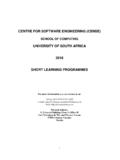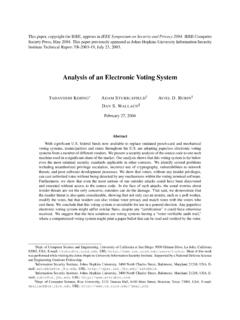Transcription of Guidelines for Snowballing in Systematic Literature ...
1 Guidelines for Snowballing in Systematic Literature studies and a Replication in software engineering Claes Wohlin Blekinge Institute of Technology SE 371 79, Karlskrona Sweden +46-(0)455-385820 ABSTRACT Background: Systematic Literature studies have become common in software engineering , and hence it is important to understand how to conduct them efficiently and reliably. Objective: This paper presents Guidelines for conducting Literature reviews using a Snowballing approach, and they are illustrated and evaluated by replicating a published Systematic Literature review.
2 Method: The Guidelines are based on the experience from conducting several Systematic Literature reviews and experimenting with different approaches. Results: The Guidelines for using Snowballing as a way to search for relevant Literature was successfully applied to a Systematic Literature review. Conclusions: It is concluded that using Snowballing , as a first search strategy, may very well be a good alternative to the use of database searches. Categories and Subject Descriptors [ software engineering ]: Management, and [Probability and Statistics]: Experimental design.
3 General Terms Experimentation, Measurement Keywords Systematic Literature review, Systematic mapping studies , Snowballing , snowball search, replication 1. INTRODUCTION Systematic Literature studies , including both reviews and maps, have emerged as a way of synthesizing evidence and then ultimately allowing researchers to come to a joint understanding of the status of a research area in software engineering in the last decade. Inspired by medicine, the concept of evidence-based software engineering was coined by Kitchenham et al.
4 [1]. Similar ideas have been brought into information systems research, by Webster and Watson [2]. However, the need to synthesize research results in software engineering was discussed already in the late 1990s [3, 4, 5]. Pickard et al. [3] discuss combining research results, Miller [4] addresses the issue of combining research results through meta-analysis and Hayes [5] uses the concept of synthesis of research results. They all have in common that they stress the need for a Systematic approach to not only conducting individual research studies , but also to building knowledge from combining findings from different studies on a topic.
5 One such early example is the work by Basili et al. [6], where the authors look into combining the research and hence knowledge we have regarding research on software inspections. Based on the original EBSE ideas [1], research related to Systematic Literature studies has subsequently evolved. Guidelines for conducting Systematic Literature reviews have been developed [7]. Systematic mapping studies have been highlighted as a complement to Systematic Literature reviews [8].
6 Kitchenham et al. [9] discuss the use of Systematic mapping studies as a starting point for further research. Here, we use Systematic Literature studies as a collective term for Systematic Literature reviews and Systematic mapping studies . This paper complements previous Guidelines for Systematic Literature reviews in software engineering . It does so by extending and detailing the steps for using Snowballing as a search approach for Systematic Literature studies . Snowballing refers to using the reference list of a paper or the citations to the paper to identify additional papers.
7 However, Snowballing could benefit from not only looking at the reference lists and citations, but to complement it with a Systematic way of looking at where papers are actually referenced and where papers are cited. Using the references and the citations respectively is referred to as backward and forward Snowballing . It builds on ideas presented by for example Webster and Watson [2] in information systems and the procedure outlined by Wohlin and Prikladnicki [10].
8 The Snowballing Guidelines are illustrated and evaluated by replicating a published reliability study of Systematic Literature reviews [11]. In this paper, the authors conducted two Systematic Literature reviews in parallel to evaluate the reliability of Literature reviews. The evaluation here provides a third data point using Snowballing as the main approach to identify relevant Literature while a database-driven search was applied in the reliability study by MacDonell et al. [11].
9 Based on the above motivation, this paper has two main research objectives: 1. Formulate a Systematic Snowballing procedure for Systematic Literature studies in software engineering , 2. Illustrate and evaluate the Snowballing procedure by replicating a published Systematic Literature review. Permission to make digital or hard copies of all or part of this work for personal or classroom use is granted without fee provided that copies are not made or distributed for profit or commercial advantage and that copies bear this notice and the full citation on the first page.
10 Copyrights for components of this work owned by others than ACM must be honored. Abstracting with credit is permitted. To copy otherwise, or republish, to post on servers or to redistribute to lists, requires prior specific permission and/or a fee. Request permissions from EASE '14, May 13 - 14 2014, London, England, BC, United Kingdom Copyright 2014 ACM 978-1-4503-2476-2/14 $ The remainder of the paper is outlined as follows. Related work is presented in Section 2.
